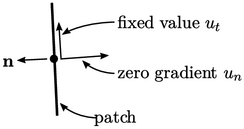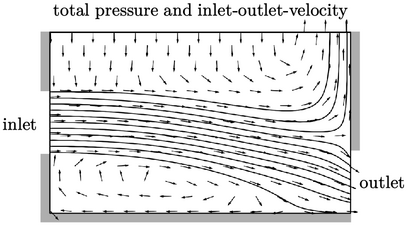4.15 Inlet-outlet-velocity condition
The inlet-outlet condition was described in Sec. 4.10 , which switches between the zero gradient type for outflow and fixed value for inflow. The condition is not so suitable for velocity, e.g. at a free boundary, since it is requires an inlet velocity to be prescribed when inflow occurs.
The switching based on the flow direction is not a
problem in itself. The flow direction comes from the sign of the flux
 ,
as noted in Eq. (4.12
), which is determined
by the solution of the pressure equation (part of pressure-velocity
coupling described in Chapter 5
).
,
as noted in Eq. (4.12
), which is determined
by the solution of the pressure equation (part of pressure-velocity
coupling described in Chapter 5
).
The problem is instead that a value of velocity cannot be chosen in the case of inflow since the inflow speed is determined by the solution within the domain. This suggests a zero gradient type as a more suitable condition.

However, Sec. 4.3 discusses that all but one variable should be prescribed at a boundary with inflow. For velocity that variable could be its normal component, while a fixed value could still be applied to the tangential component.
The direction mixed type described in
Sec. 4.14
provides the framework
to implement this condition. A reference value  is specified and the
reference gradient is zero, i.e.
is specified and the
reference gradient is zero, i.e.  .
.
The value fraction tensor is calculated as
 |
(4.26) |
 tangential to the
boundary, which can be calculated by subtracting the normal
component from a specified
tangential to the
boundary, which can be calculated by subtracting the normal
component from a specified  by
by 

This inlet-outlet-velocity condition can be
applied at the free boundary in the example from Sec. 4.6
. For free boundaries like this,
 is
the only practical specification, which causes all inflow to be
normal to the free boundary, as shown above.
is
the only practical specification, which causes all inflow to be
normal to the free boundary, as shown above.
The solution is clearly different to that using
 shown on page 267
. There, the inflow
direction is determined by the solution rather than prescribed. The
solution with
shown on page 267
. There, the inflow
direction is determined by the solution rather than prescribed. The
solution with  may be more accurate but the inlet-outlet-velocity
condition adheres better to the general principles of boundary
conditions, so is likely to be more stable.
may be more accurate but the inlet-outlet-velocity
condition adheres better to the general principles of boundary
conditions, so is likely to be more stable.
It becomes less contentious to set  with the
inlet-outlet-velocity condition as the boundary is moved further
into the far field, where the flow is more quiescent.
with the
inlet-outlet-velocity condition as the boundary is moved further
into the far field, where the flow is more quiescent.

